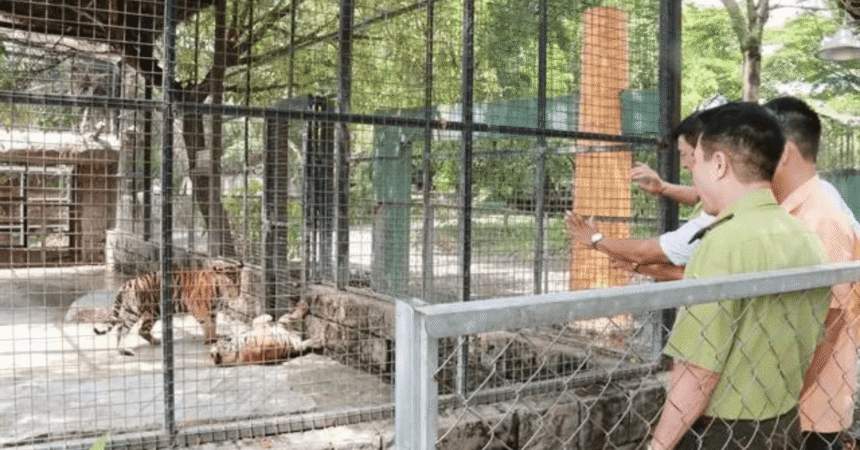In a deeply concerning incident for wildlife conservation, recent reports reveal that 47 tigers, three lions, and a panther have died in zoos across southern Vietnam as a result of the H5N1 bird flu virus. This outbreak highlights not only the fragility of wildlife populations but also the broader implications for public health and biodiversity.
Overview of the Incident
The tragic fatalities occurred primarily in two facilities: the My Quynh safari park in Long An province and the Vuon Xoai zoo in Dong Nai, located near Ho Chi Minh City. The Vietnamese state media outlet, the Vietnam News Agency (VNA), reported that these deaths transpired in August and September 2023. According to tests conducted by the National Centre for Animal Health Diagnosis, the fatalities were directly attributed to the H5N1 type A virus.
Both zoos involved have refrained from commenting on the situation when approached by AFP for further details, raising questions about transparency and the dissemination of crucial information during a health crisis.
Understanding H5N1 and Its Impact
H5N1, a highly pathogenic avian influenza virus, primarily affects birds but has been known to infect various mammals, including domestic cats and big cats in captivity. The strain has garnered attention due to its potential to cause severe respiratory illness in humans, making its presence in wildlife particularly alarming.
Transmission and Symptoms
Bird flu viruses typically spread among birds through contaminated water, surfaces, or contact with infected animals. However, in recent years, there have been increasing reports of the virus affecting mammalian species. Symptoms in infected animals can range from mild respiratory distress to severe illness, often leading to death.
The WHO has warned that infections caused by H5N1 can vary in severity among humans, with some cases resulting in fatalities. Since 2022, the organization has observed an uptick in deadly outbreaks among mammals, signaling a potential shift in how these viruses are affecting wildlife and the broader ecosystem.
The Human Connection
While the immediate concern lies with the tigers and other big cats that have died, there are significant implications for human health as well. Vietnam has been proactive in monitoring for potential zoonotic diseases—those that can jump from animals to humans. The nation reported a human death linked to the H5N1 virus in March 2023, prompting health authorities to intensify surveillance measures.
Zoonotic Transmission
Zoonotic diseases pose a complex challenge to public health, particularly in regions where humans and animals coexist closely. The risk of transmission increases in environments where wild and domestic animals interact. For instance, the same ecosystems that house wildlife may also be home to agricultural practices involving poultry, creating avenues for cross-species infections.
This situation raises questions about biosecurity measures in wildlife facilities and the importance of safeguarding both animal and human health. The recent outbreak underscores the need for coordinated efforts between wildlife conservationists and public health officials to monitor and manage risks associated with zoonotic diseases.
Current Status of Tigers in Vietnam
According to the NGO Education for Nature Vietnam (ENV), the captive tiger population in Vietnam stood at 385 by the end of 2023. Of these, approximately 310 tigers reside in privately owned farms and zoos, while the remainder is housed in state-run facilities. The recent deaths significantly impact this already vulnerable population.
Challenges for Captive Tigers
Vietnam’s tiger population is under significant threat due to habitat loss, poaching, and illegal wildlife trade. The loss of 47 tigers in a short period highlights the urgent need for better health management practices within captivity. As conservationists strive to protect and rehabilitate tiger populations, incidents like this emphasize the fragility of these efforts.
Historical Context of H5N1 in Wildlife
This incident is not isolated; H5N1 has had previous impacts on wildlife populations. In 2004, a significant outbreak occurred at the world’s largest breeding farm for tigers in Thailand, resulting in the deaths or culling of numerous animals. Such historical precedents highlight the ongoing risk posed by avian influenza to captive and wild animal populations.
Lessons from the Past
Past outbreaks have shown the necessity for robust health monitoring systems in wildlife facilities. The loss of tigers in both Thailand and Vietnam serves as a critical reminder of the vulnerabilities that wildlife face and the importance of establishing preventive measures.
Conservation Implications
The recent deaths in Vietnam underscore a broader crisis in wildlife conservation efforts. The loss of such a significant number of tigers not only affects the species’ population but also has cascading effects on biodiversity and ecosystem stability.
Need for Enhanced Biosecurity Measures
As wildlife facilities become increasingly susceptible to infectious diseases, conservationists are advocating for heightened biosecurity protocols. This includes regular health assessments, improved sanitation practices, and better training for staff to recognize symptoms of infectious diseases.
Furthermore, collaboration between zoos, wildlife agencies, and health organizations can foster a more integrated approach to wildlife health management. The sharing of information regarding disease outbreaks and health protocols can significantly enhance the overall resilience of wildlife populations.
Future Outlook
As Vietnam grapples with the consequences of this tragic incident, the path forward will require a multifaceted approach to wildlife conservation and public health.
Strengthening Regulations
Policymakers must prioritize the establishment of regulatory frameworks that ensure the health and well-being of captive wildlife. This includes setting standards for animal care, disease prevention, and emergency response protocols in the event of an outbreak.
Community Engagement and Education
Raising public awareness about the risks associated with zoonotic diseases is crucial. Educational initiatives that inform local communities about the importance of wildlife conservation and the potential health risks can foster greater support for protective measures.
Additionally, engaging local communities in conservation efforts can promote sustainable practices that reduce human-wildlife conflict and support the preservation of natural habitats.
Conclusion
The loss of 47 tigers and other big cats in Vietnam due to the H5N1 bird flu virus is a tragic reminder of the fragility of wildlife populations in the face of disease. As authorities and conservationists work to address the implications of this outbreak, it serves as a wake-up call for improved health management practices and collaboration between wildlife and public health sectors.
As we move forward, it is essential to recognize the interconnectedness of wildlife health and human well-being. Only through proactive measures and collective efforts can we hope to safeguard the remaining tiger populations and prevent future outbreaks that threaten both wildlife and human communities.
Call to Action
In light of this incident, it is imperative for governments, NGOs, and the public to unite in their efforts to protect wildlife and ensure the safety of human populations. Increased funding for wildlife health research, the establishment of robust monitoring systems, and community education initiatives will play pivotal roles in preventing future outbreaks and promoting conservation efforts.
The survival of tigers and other endangered species hinges on our ability to adapt and respond to emerging threats. By fostering collaboration and prioritizing the health of both wildlife and humans, we can work towards a more sustainable future for all.
#BirdFlu #H5N1 #WildlifeConservation #Tigers #Vietnam #ZooHealth #ZoonoticDiseases #PublicHealth #Biodiversity







